Giovanni Di Stefano – Errori Significanti
-scaled.jpg)
Mostra antologica. Opere dal 1983 al 2022.
Comunicato stampa
Giovanni Di Stefano
Errori Significanti
Opere dal 1983 al 2022
Inaugurazione
giovedì 19 maggio 2022
17 - 21
Con un testo di Anna Homberg
e un'intervista all'artista di Cesare Pietroiusti
scroll down for english version
Difficile comprendere l’evoluzione della quarantennale ricerca artistica di Giovanni Di Stefano (Roma, 1958) senza leggere le sue opere come veri e propri esperimenti interattivi, che prima di avere un valore estetico hanno una dichiarata valenza scientifica. Questa impronta, che lo ricollega direttamente alla Teoria Eventualista, è chiara fin dai suoi esordi e resta una chiave di lettura valida per tutta la sua produzione, di cui la mostra offre una panoramica antologica.
Nel 1982, quando era un ventiquattrenne studente di pittura dell’Accademia di Belli Arti, Di Stefano entra a far parte del Centro Studi Jartrakor - fondato a Roma nel 1977 da Sergio Lombardo, Anna Homberg e Cesare Pietroiusti - e dimostra fin da subito di aderire ai principi dell’Eventualismo. Ne sono testimonianza i suoi Esperimenti di pittura cieca dei primi anni Ottanta, di cui un’ampia selezione apre il percorso espositivo. In queste opere la realizzazione materiale veniva delegata dall’artista a un esecutore altro che doveva, con gli occhi bendati, ricoprire (a pennarello o a grafite) la superficie di una forma geometrica semplice (un cerchio o un quadrato, disegnati su cartoncino) in un lasso di tempo determinato. Come un vero scienziato, Di Stefano forniva il materiale e le regole dell’esperimento, lo osservava e ne studiava poi i risultati, cercando eventuali corrispondenze tra il risultato estetico e la personalità dell’esecutore. Altre volte gli capitava di prendere parte in prima persona agli esperimenti di pittura cieca, come nell’evento tenutosi a Jartrakor il 13 gennaio 1984: qui l'artista intervenne, con un bastoncino di grafite e una benda sugli occhi, su un cerchio disegnato su un grande foglio di cartoncino (270 x 270 cm) fissato a terra, inscenando una vera e propria azione performativa, durata un’ora e quarantacinque minuti, di cui l’opera ha assorbito tutti i segni “corporei” [...]
Giovanni Di Stefano
Significant Errors
Works from 1983 to 2022
Opening
Thursday, May 19, 2022
5 - 9 pm
With a text by Anna Homberg
and an interview to the artist by Cesare Pietroiusti
The evolution of the forty-year long artistic research by Giovanni Di Stefano (Rome, 1958) is hard to understand without interpreting his works as actual interactive experiments having an open scientific value, rather just an aesthetic one. This aspect, which directly links him to the Eventualist Theory, is clear from the very beginning of his career and it is key to understand his entire production, of which the exhibition presents an anthological overview.
In 1982, when he was a twenty-four-year-old student of the Academy of Fine Arts, Di Stefano joined the Jartrakor Research Centre, which was founded in Rome in 1977 by Sergio Lombardo, Anna Homberg, and Cesare Pietroiusti. Since the beginning, it was clear that he adhered to Eventualist principles. This is shown in his Experiments of Blind Painting from the early 80s, a wide selection of which opens the exhibition. In these works, the artist delegated the production to another blindfolded executor, who had to cover - using either a marker or graphite - the surface of a simple geometric shape (i.e., a circle or a square, drawn on cardboard) in a set time frame. As a real scientist, Di Stefano provided the materials and explained the rules of the experiment. Then, he observed and studied the results, looking for any match between the aesthetic result and the executor's personality. Sometimes, he was personally involved in the blind painting experiments, like in the event held in Jartrakor on 13 January 1984. On that occasion, the artist, who was blindfolded, used a graphite stick on a circle drawn on a wide cardboard paper (270 x 270 cm) fixed to the ground, thus putting on an actual one-hour-and-forty-five-minute-long performative act, during which the artwork absorbed all his ‘body’ signs [...]



